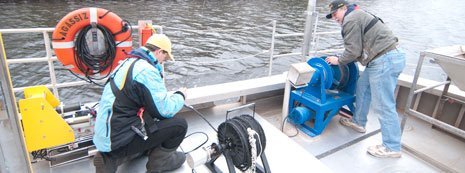Transformation of dissolved organic matter in engineered ultraviolet (UV) photolysis and UV-based advanced oxidation processes
Document Type
Presentation
Publication Date
2017
Abstract
Photolysis with ultraviolet (UV) light is an established technology for disinfection of pathogens and potential oxidation of chemical contaminants in water and wastewater treatment processes. UV-based advanced oxidation processes (AOPs) such as UV/hydrogen peroxide, UV/chlorine, and UV/persulfate are promising technologies to destroy a wide variety of organic compounds due to the formation of reactive radical species such as hydroxyl radicals (HOÉ_Ω), chlorine radicals (ClÉ_Ω), and sulfate radicals (SO4É_Ω-). The presence of dissolved organic matter (DOM) can affect the performance of UV photolysis and UV-based AOPs. Photons emitted by UV lamps are absorbed and the radical species are scavenged by DOM and consequently reduce the efficiency of photolysis and oxidation on one hand. On the other hand, DOM play a role as a sensitizer during photolysis to produce the active radical species that can enhance the degradation of target organics. However, a complex mixture of heterogeneous DOM makes it hard to predict the fate of pathogens and chemical contaminants in engineered UV photolysis and UV-based AOPs. This study aims to understand the molecular level DOM transformation induced by UV irradiation and reactive radical species. It is hypothesized that the different reactivity of photons (i.e., excitation) and radical species hence reaction mechanisms (e.g., abstraction, addition and electron-transfer) can cause the different patter of DOM transformation. By understanding the DOM transformation, we could design UV and UV-based technologies based on the given DOM property. As a start, we used Suwannee River Fulvic and Humic Acids as DOM standard surrogates. The sample solution with approximately 10 mgC/L of DOC was irradiated by a 25 W low pressure UV lamp in the absence or presence of hydrogen peroxide, free chlorine, or peroxydisulfate. The reactive radicals were quantified using probe compounds (e.g., para-chlorobenzoic acid). Concentrations of singlet oxygen and triplet state of DOM were also determined using furfuryl alcohol and 2,4,6 trimethylphenol, respectively. We used a Thermo Scientific Orbitrap Elite Hybrid Ion Trap Mass Spectrometer in negative-ion mode to determine the elemental compositions of DOM. A two-dimensional van Krevelen diagram that represents the ratios of H/C and O/C was generated to visualize the DOM transformation. Preliminary results indicate an increase in H/C ratio among majority of the photolyzed samples, which could be an indication of an increase in the degree of saturation of carbon-carbon double bonds. Predominantly, molecules with a O/C ratio greater than 1 appear to be more among the photolyzed samples, which was attributed by the partial oxidation. This is the first study that investigated the molecular-level DOM transformation during UV photolysis and various UV-based AOPs.
Publication Title
AEESP 2017
Recommended Citation
Varanasi, L.,
Coscarelli, E.,
Khaksari, M.,
Mazzoleni, L.,
&
Minakata, D.
(2017).
Transformation of dissolved organic matter in engineered ultraviolet (UV) photolysis and UV-based advanced oxidation processes.
AEESP 2017.
Retrieved from: https://digitalcommons.mtu.edu/cee-fp/20


Publisher's Statement
Publisher's version of record: https://aeesp2017.com/program_list.php?sid=S7#a115